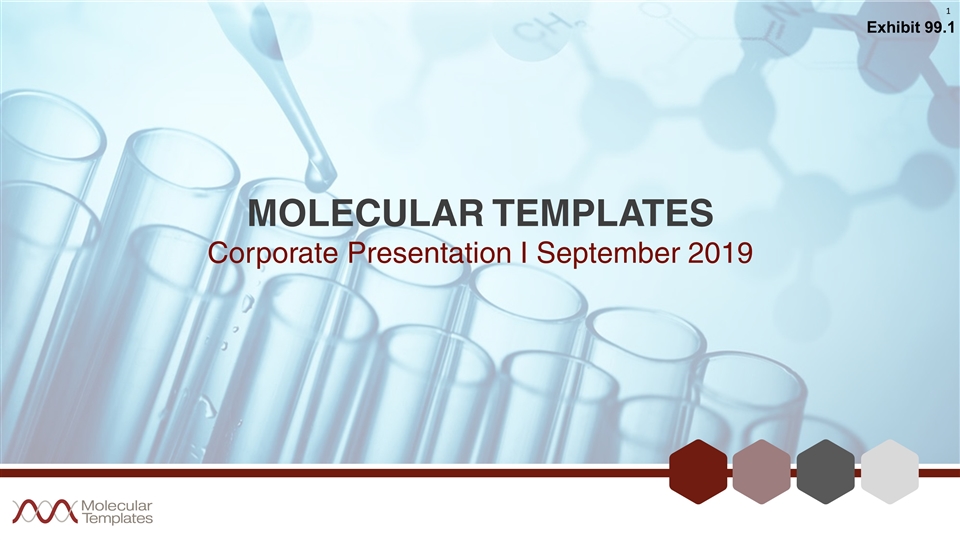
MOLECULAR TEMPLATES Corporate Presentation I September 2019 (NASDAQ: MTEM) Exhibit 99.1
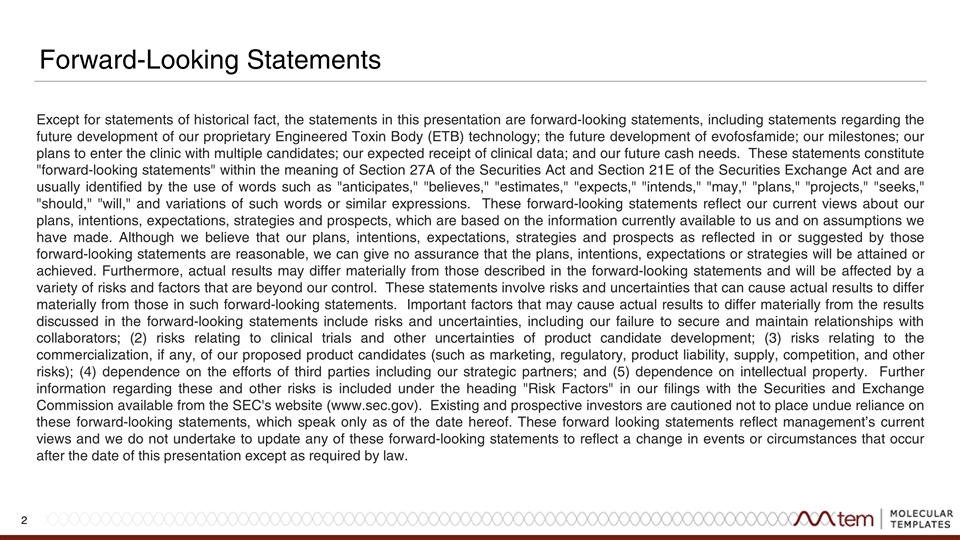
Forward-Looking Statements Except for statements of historical fact, the statements in this presentation are forward-looking statements, including statements regarding the future development of our proprietary Engineered Toxin Body (ETB) technology; the future development of evofosfamide; our milestones; our plans to enter the clinic with multiple candidates; our expected receipt of clinical data; and our future cash needs. These statements constitute "forward-looking statements" within the meaning of Section 27A of the Securities Act and Section 21E of the Securities Exchange Act and are usually identified by the use of words such as "anticipates," "believes," "estimates," "expects," "intends," "may," "plans," "projects," "seeks," "should," "will," and variations of such words or similar expressions. These forward-looking statements reflect our current views about our plans, intentions, expectations, strategies and prospects, which are based on the information currently available to us and on assumptions we have made. Although we believe that our plans, intentions, expectations, strategies and prospects as reflected in or suggested by those forward-looking statements are reasonable, we can give no assurance that the plans, intentions, expectations or strategies will be attained or achieved. Furthermore, actual results may differ materially from those described in the forward-looking statements and will be affected by a variety of risks and factors that are beyond our control. These statements involve risks and uncertainties that can cause actual results to differ materially from those in such forward-looking statements. Important factors that may cause actual results to differ materially from the results discussed in the forward-looking statements include risks and uncertainties, including our failure to secure and maintain relationships with collaborators; (2) risks relating to clinical trials and other uncertainties of product candidate development; (3) risks relating to the commercialization, if any, of our proposed product candidates (such as marketing, regulatory, product liability, supply, competition, and other risks); (4) dependence on the efforts of third parties including our strategic partners; and (5) dependence on intellectual property. Further information regarding these and other risks is included under the heading "Risk Factors" in our filings with the Securities and Exchange Commission available from the SEC's website (www.sec.gov). Existing and prospective investors are cautioned not to place undue reliance on these forward-looking statements, which speak only as of the date hereof. These forward looking statements reflect management’s current views and we do not undertake to update any of these forward-looking statements to reflect a change in events or circumstances that occur after the date of this presentation except as required by law.
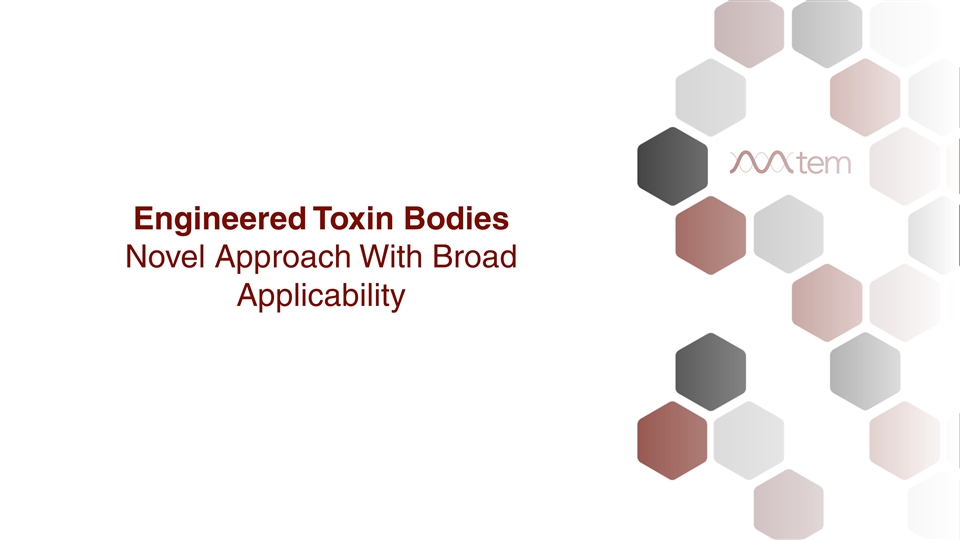
Engineered Toxin Bodies Novel Approach With Broad Applicability
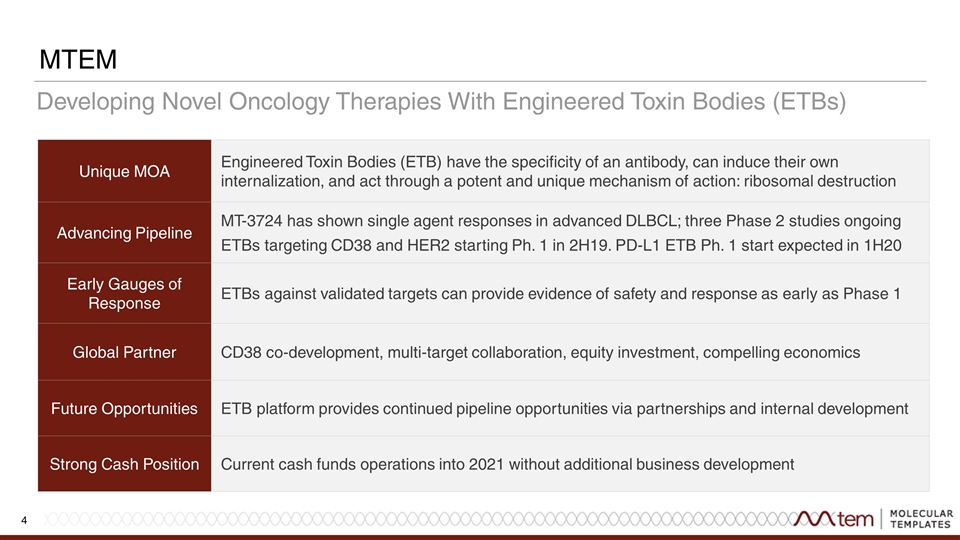
MTEM Developing Novel Oncology Therapies With Engineered Toxin Bodies (ETBs) Unique MOA Engineered Toxin Bodies (ETB) have the specificity of an antibody, can induce their own internalization, and act through a potent and unique mechanism of action: ribosomal destruction Advancing Pipeline MT-3724 has shown single agent responses in advanced DLBCL; three Phase 2 studies ongoing ETBs targeting CD38 and HER2 starting Ph. 1 in 2H19. PD-L1 ETB Ph. 1 start expected in 1H20 Early Gauges of Response ETBs against validated targets can provide evidence of safety and response as early as Phase 1 Global Partner CD38 co-development, multi-target collaboration, equity investment, compelling economics Future Opportunities ETB platform provides continued pipeline opportunities via partnerships and internal development Strong Cash Position Current cash funds operations into 2021 without additional business development
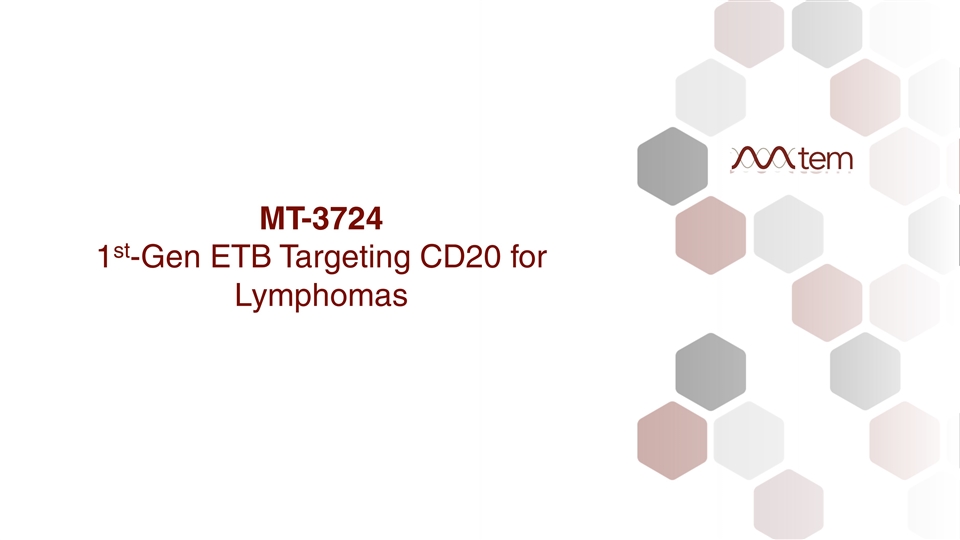
MT-3724 1st-Gen ETB Targeting CD20 for Lymphomas
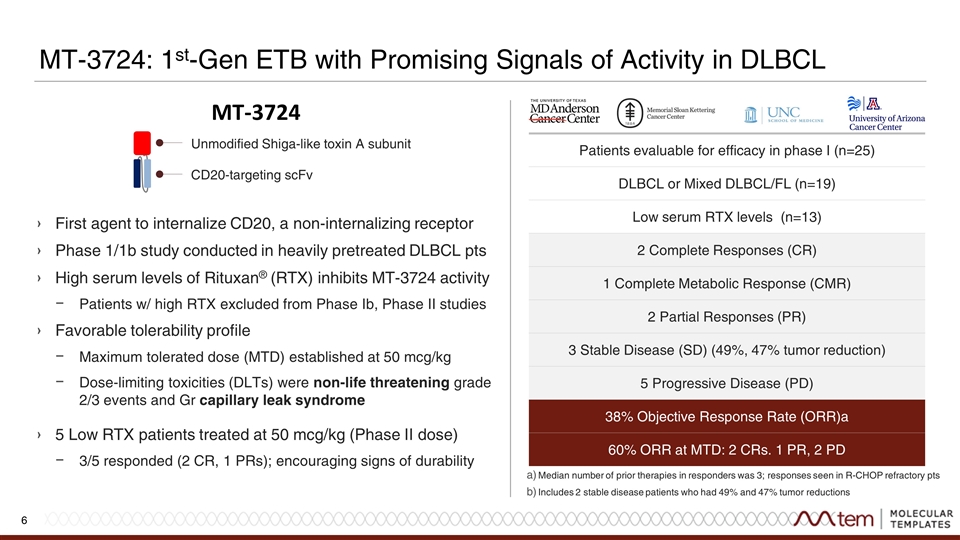
Patients evaluable for efficacy in phase I (n=25) DLBCL or Mixed DLBCL/FL (n=19) Low serum RTX levels (n=13) 2 Complete Responses (CR) 1 Complete Metabolic Response (CMR) 2 Partial Responses (PR) 3 Stable Disease (SD) (49%, 47% tumor reduction) 5 Progressive Disease (PD) 38% Objective Response Rate (ORR)a 60% ORR at MTD: 2 CRs. 1 PR, 2 PD MT-3724: 1st-Gen ETB with Promising Signals of Activity in DLBCL First agent to internalize CD20, a non-internalizing receptor Phase 1/1b study conducted in heavily pretreated DLBCL pts High serum levels of Rituxan® (RTX) inhibits MT-3724 activity Patients w/ high RTX excluded from Phase Ib, Phase II studies Favorable tolerability profile Maximum tolerated dose (MTD) established at 50 mcg/kg Dose-limiting toxicities (DLTs) were non-life threatening grade 2/3 events and Gr capillary leak syndrome 5 Low RTX patients treated at 50 mcg/kg (Phase II dose) 3/5 responded (2 CR, 1 PRs); encouraging signs of durability Median number of prior therapies in responders was 3; responses seen in R-CHOP refractory pts Includes 2 stable disease patients who had 49% and 47% tumor reductions Unmodified Shiga-like toxin A subunit CD20-targeting scFv MT-3724
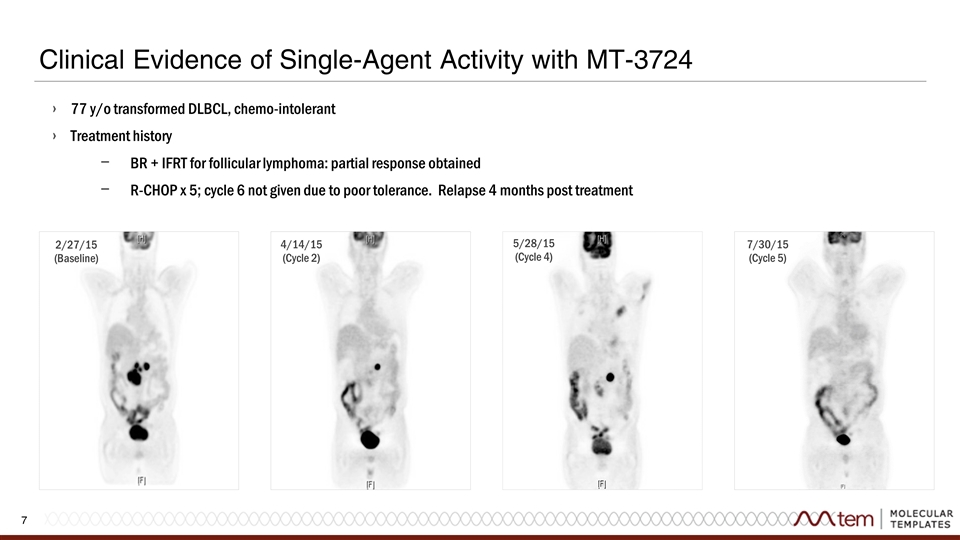
Clinical Evidence of Single-Agent Activity with MT-3724 7/30/15 (Cycle 5) 4/14/15 (Cycle 2) 5/28/15 (Cycle 4) 2/27/15 (Baseline) 77 y/o transformed DLBCL, chemo-intolerant Treatment history BR + IFRT for follicular lymphoma: partial response obtained R-CHOP x 5; cycle 6 not given due to poor tolerance. Relapse 4 months post treatment
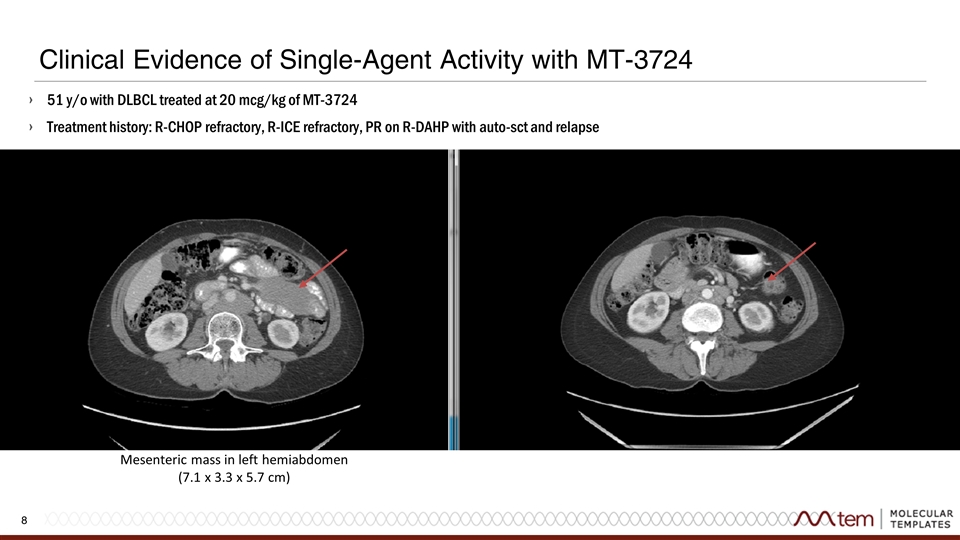
Clinical Evidence of Single-Agent Activity with MT-3724 Mesenteric mass in left hemiabdomen (7.1 x 3.3 x 5.7 cm) 51 y/o with DLBCL treated at 20 mcg/kg of MT-3724 Treatment history: R-CHOP refractory, R-ICE refractory, PR on R-DAHP with auto-sct and relapse
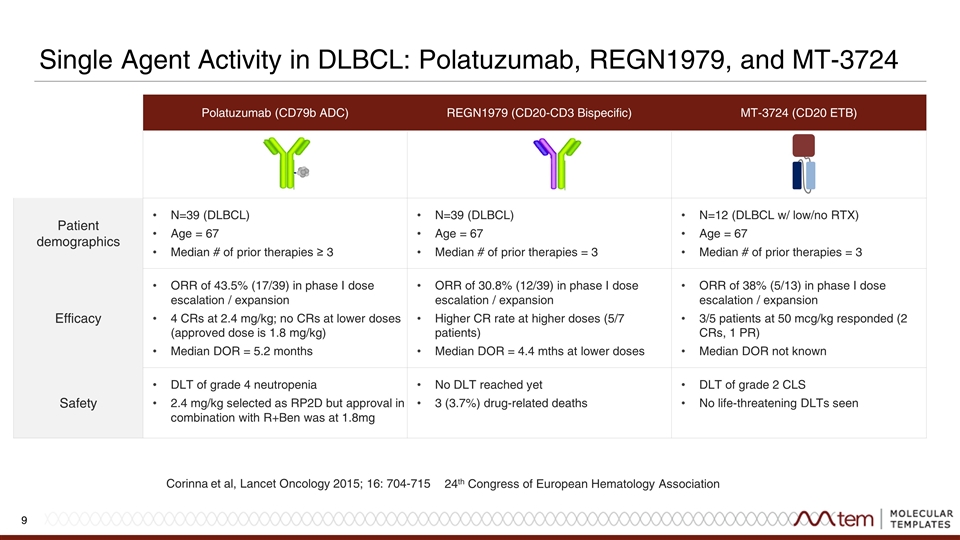
Polatuzumab (CD79b ADC) REGN1979 (CD20-CD3 Bispecific) MT-3724 (CD20 ETB) Patient demographics N=39 (DLBCL) Age = 67 Median # of prior therapies ≥ 3 N=39 (DLBCL) Age = 67 Median # of prior therapies = 3 N=12 (DLBCL w/ low/no RTX) Age = 67 Median # of prior therapies = 3 Efficacy ORR of 43.5% (17/39) in phase I dose escalation / expansion 4 CRs at 2.4 mg/kg; no CRs at lower doses (approved dose is 1.8 mg/kg) Median DOR = 5.2 months ORR of 30.8% (12/39) in phase I dose escalation / expansion Higher CR rate at higher doses (5/7 patients) Median DOR = 4.4 mths at lower doses ORR of 38% (5/13) in phase I dose escalation / expansion 3/5 patients at 50 mcg/kg responded (2 CRs, 1 PR) Median DOR not known Safety DLT of grade 4 neutropenia 2.4 mg/kg selected as RP2D but approval in combination with R+Ben was at 1.8mg No DLT reached yet 3 (3.7%) drug-related deaths DLT of grade 2 CLS No life-threatening DLTs seen Single Agent Activity in DLBCL: Polatuzumab, REGN1979, and MT-3724 Corinna et al, Lancet Oncology 2015; 16: 704-715 24th Congress of European Hematology Association
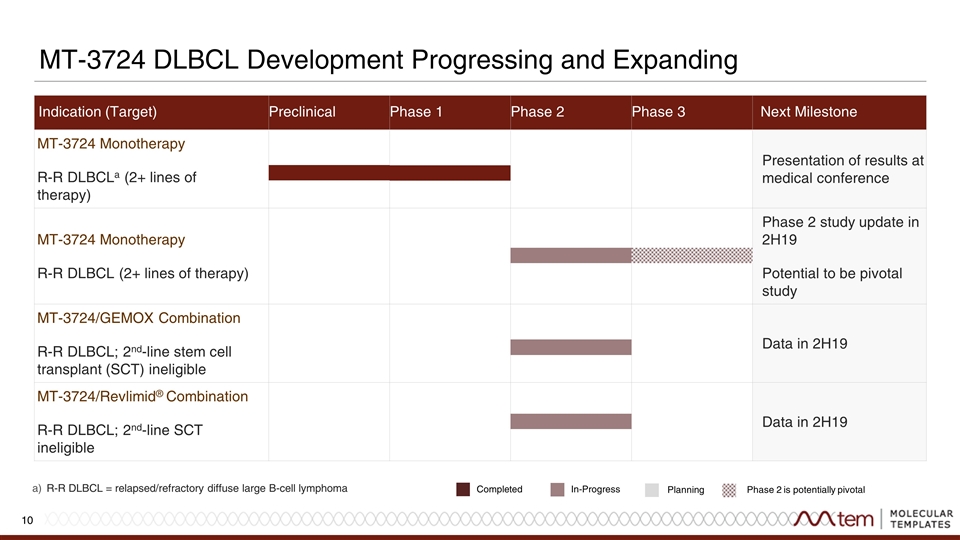
MT-3724 DLBCL Development Progressing and Expanding Indication (Target) Preclinical Phase 1 Phase 2 Phase 3 Next Milestone MT-3724 Monotherapy R-R DLBCLa (2+ lines of therapy) Presentation of results at medical conference MT-3724 Monotherapy R-R DLBCL (2+ lines of therapy) Phase 2 study update in 2H19 Potential to be pivotal study MT-3724/GEMOX Combination R-R DLBCL; 2nd-line stem cell transplant (SCT) ineligible Data in 2H19 MT-3724/Revlimid® Combination R-R DLBCL; 2nd-line SCT ineligible Data in 2H19 R-R DLBCL = relapsed/refractory diffuse large B-cell lymphoma In-Progress Completed Planning Phase 2 is potentially pivotal
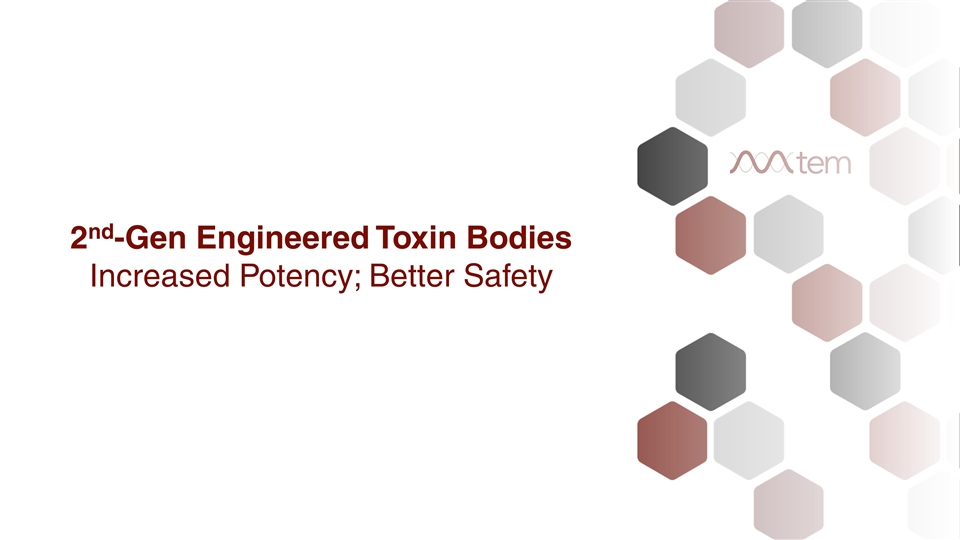
2nd-Gen Engineered Toxin Bodies Increased Potency; Better Safety
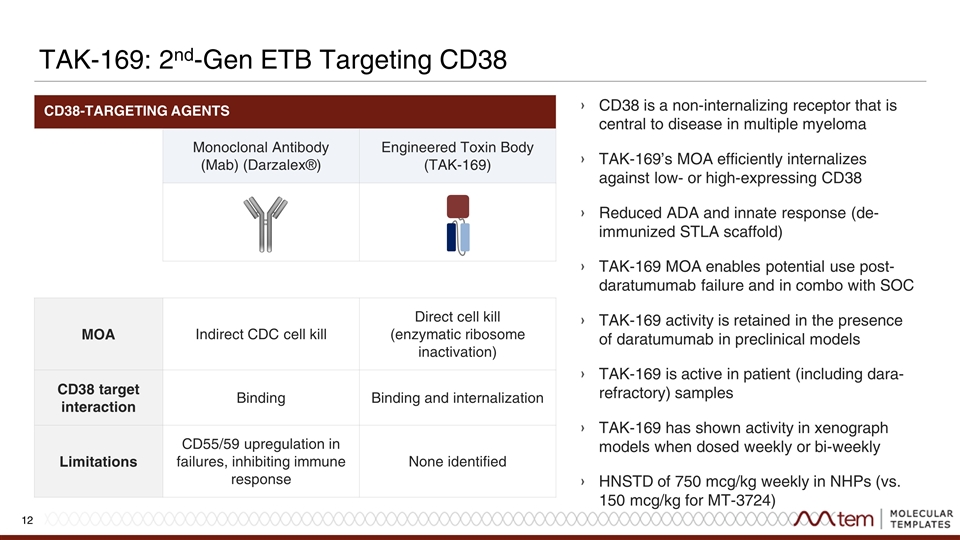
CD38-targeting agents Monoclonal Antibody (Mab) (Darzalex®) Engineered Toxin Body (TAK-169) MOA Indirect CDC cell kill Direct cell kill (enzymatic ribosome inactivation) CD38 target interaction Binding Binding and internalization Limitations CD55/59 upregulation in failures, inhibiting immune response None identified CD38 is a non-internalizing receptor that is central to disease in multiple myeloma TAK-169’s MOA efficiently internalizes against low- or high-expressing CD38 Reduced ADA and innate response (de-immunized STLA scaffold) TAK-169 MOA enables potential use post-daratumumab failure and in combo with SOC TAK-169 activity is retained in the presence of daratumumab in preclinical models TAK-169 is active in patient (including dara-refractory) samples TAK-169 has shown activity in xenograph models when dosed weekly or bi-weekly HNSTD of 750 mcg/kg weekly in NHPs (vs. 150 mcg/kg for MT-3724) TAK-169: 2nd-Gen ETB Targeting CD38
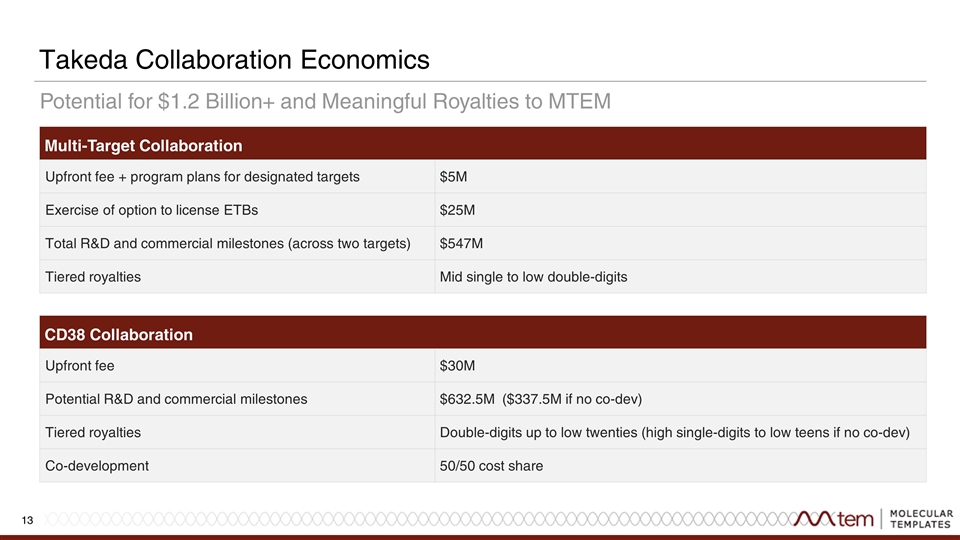
Potential for $1.2 Billion+ and Meaningful Royalties to MTEM Multi-Target Collaboration Upfront fee + program plans for designated targets $5M Exercise of option to license ETBs $25M Total R&D and commercial milestones (across two targets) $547M Tiered royalties Mid single to low double-digits Takeda Collaboration Economics CD38 Collaboration Upfront fee $30M Potential R&D and commercial milestones $632.5M ($337.5M if no co-dev) Tiered royalties Double-digits up to low twenties (high single-digits to low teens if no co-dev) Co-development 50/50 cost share
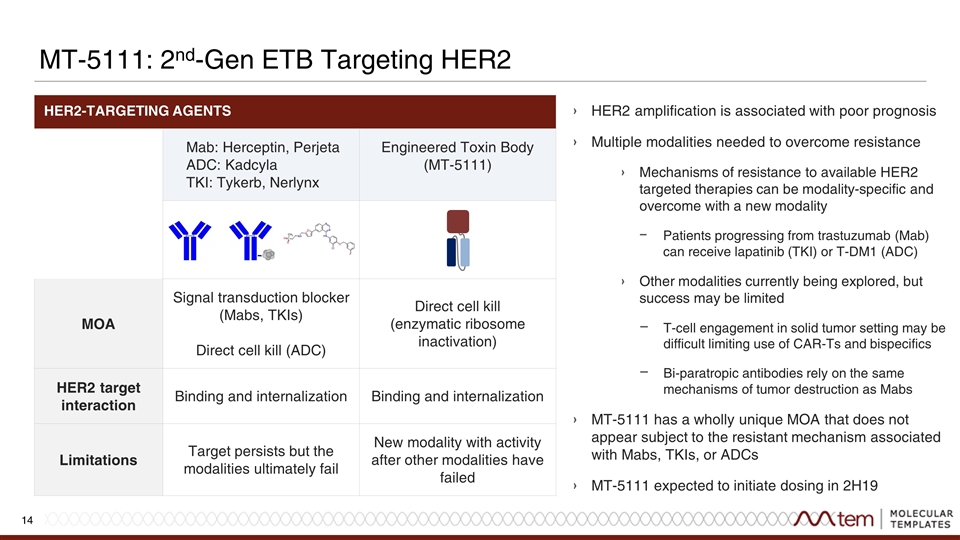
HER2-targeting agents Mab: Herceptin, Perjeta ADC: Kadcyla TKI: Tykerb, Nerlynx Engineered Toxin Body (MT-5111) MOA Signal transduction blocker (Mabs, TKIs) Direct cell kill (ADC) Direct cell kill (enzymatic ribosome inactivation) HER2 target interaction Binding and internalization Binding and internalization Limitations Target persists but the modalities ultimately fail New modality with activity after other modalities have failed MT-5111: 2nd-Gen ETB Targeting HER2 HER2 amplification is associated with poor prognosis Multiple modalities needed to overcome resistance Mechanisms of resistance to available HER2 targeted therapies can be modality-specific and overcome with a new modality Patients progressing from trastuzumab (Mab) can receive lapatinib (TKI) or T-DM1 (ADC) Other modalities currently being explored, but success may be limited T-cell engagement in solid tumor setting may be difficult limiting use of CAR-Ts and bispecifics Bi-paratropic antibodies rely on the same mechanisms of tumor destruction as Mabs MT-5111 has a wholly unique MOA that does not appear subject to the resistant mechanism associated with Mabs, TKIs, or ADCs MT-5111 expected to initiate dosing in 2H19
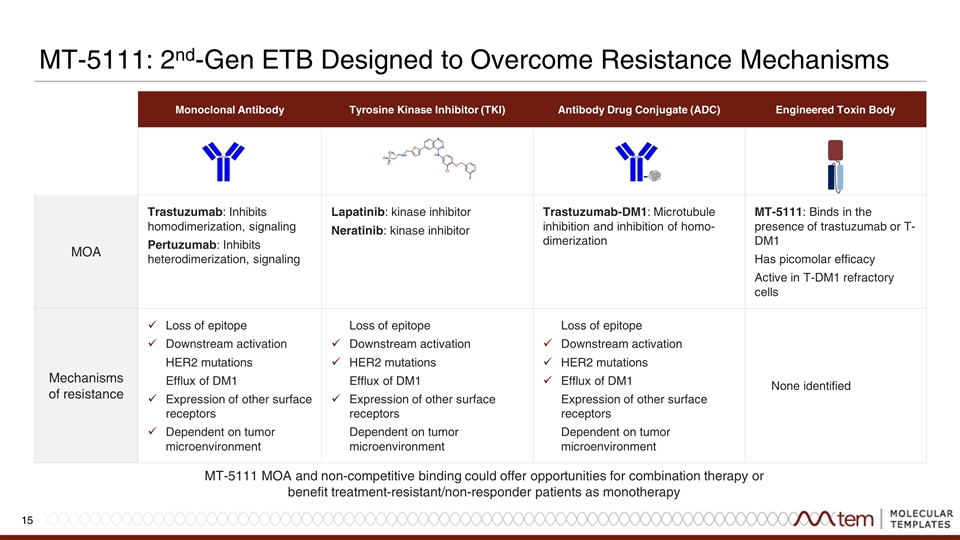
Monoclonal Antibody Tyrosine Kinase Inhibitor (TKI) Antibody Drug Conjugate (ADC) Engineered Toxin Body MOA Trastuzumab: Inhibits homodimerization, signaling Pertuzumab: Inhibits heterodimerization, signaling Lapatinib: kinase inhibitor Neratinib: kinase inhibitor Trastuzumab-DM1: Microtubule inhibition and inhibition of homo-dimerization MT-5111: Binds in the presence of trastuzumab or T-DM1 Has picomolar efficacy Active in T-DM1 refractory cells Mechanisms of resistance Loss of epitope Downstream activation HER2 mutations Efflux of DM1 Expression of other surface receptors Dependent on tumor microenvironment Loss of epitope Downstream activation HER2 mutations Efflux of DM1 Expression of other surface receptors Dependent on tumor microenvironment Loss of epitope Downstream activation HER2 mutations Efflux of DM1 Expression of other surface receptors Dependent on tumor microenvironment None identified MT-5111: 2nd-Gen ETB Designed to Overcome Resistance Mechanisms MT-5111 MOA and non-competitive binding could offer opportunities for combination therapy or benefit treatment-resistant/non-responder patients as monotherapy
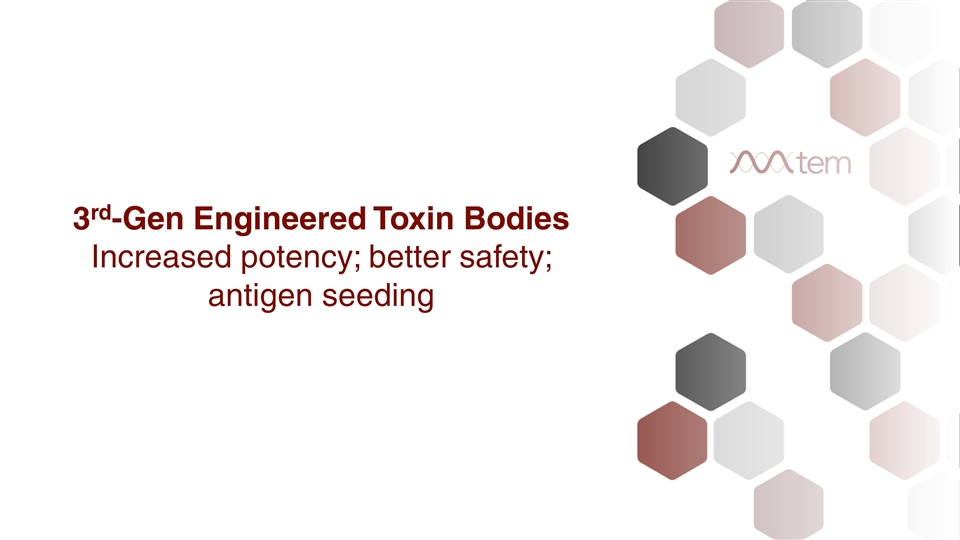
3rd-Gen Engineered Toxin Bodies Increased potency; better safety; antigen seeding
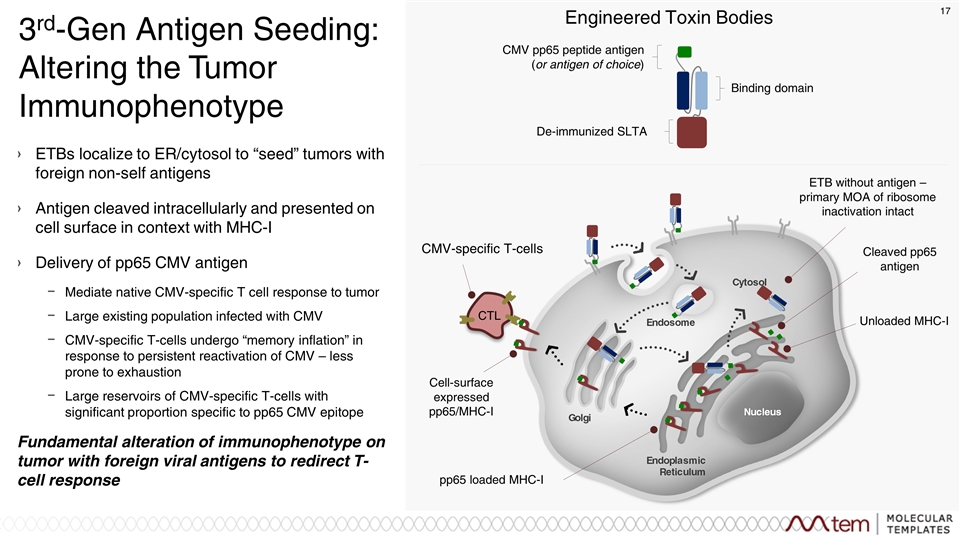
3rd-Gen Antigen Seeding: Altering the Tumor Immunophenotype ETBs localize to ER/cytosol to “seed” tumors with foreign non-self antigens Antigen cleaved intracellularly and presented on cell surface in context with MHC-I Delivery of pp65 CMV antigen Mediate native CMV-specific T cell response to tumor Large existing population infected with CMV CMV-specific T-cells undergo “memory inflation” in response to persistent reactivation of CMV – less prone to exhaustion Large reservoirs of CMV-specific T-cells with significant proportion specific to pp65 CMV epitope Fundamental alteration of immunophenotype on tumor with foreign viral antigens to redirect T-cell response Binding domain CMV pp65 peptide antigen (or antigen of choice) Engineered Toxin Bodies De-immunized SLTA Cell-surface expressed pp65/MHC-I ETB without antigen – primary MOA of ribosome inactivation intact Unloaded MHC-I pp65 loaded MHC-I Cleaved pp65 antigen CMV-specific T-cells CTL
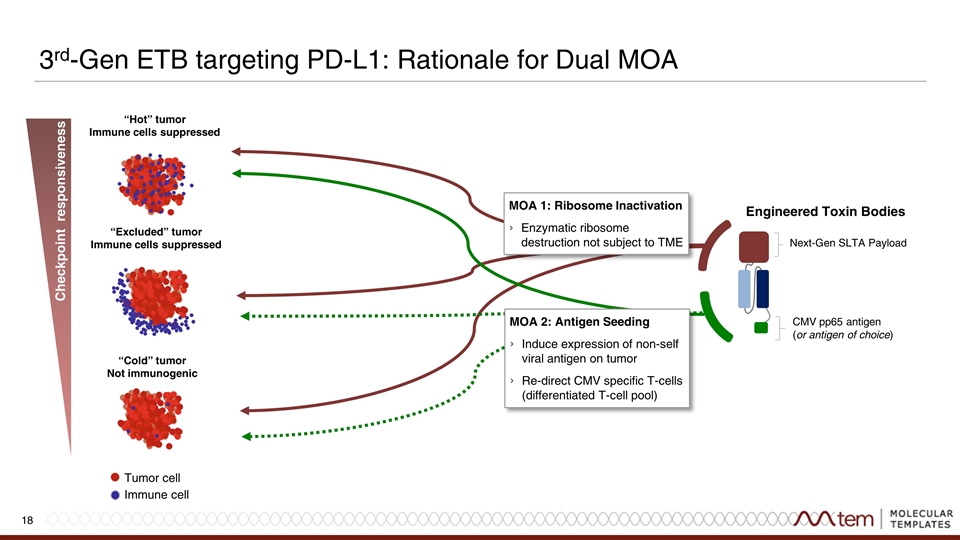
3rd-Gen ETB targeting PD-L1: Rationale for Dual MOA Next-Gen SLTA Payload CMV pp65 antigen (or antigen of choice) Engineered Toxin Bodies Tumor cell Immune cell “Cold” tumor Not immunogenic “Hot” tumor Immune cells suppressed “Excluded” tumor Immune cells suppressed Checkpoint responsiveness MOA 1: Ribosome Inactivation Enzymatic ribosome destruction not subject to TME MOA 2: Antigen Seeding Induce expression of non-self viral antigen on tumor Re-direct CMV specific T-cells (differentiated T-cell pool)
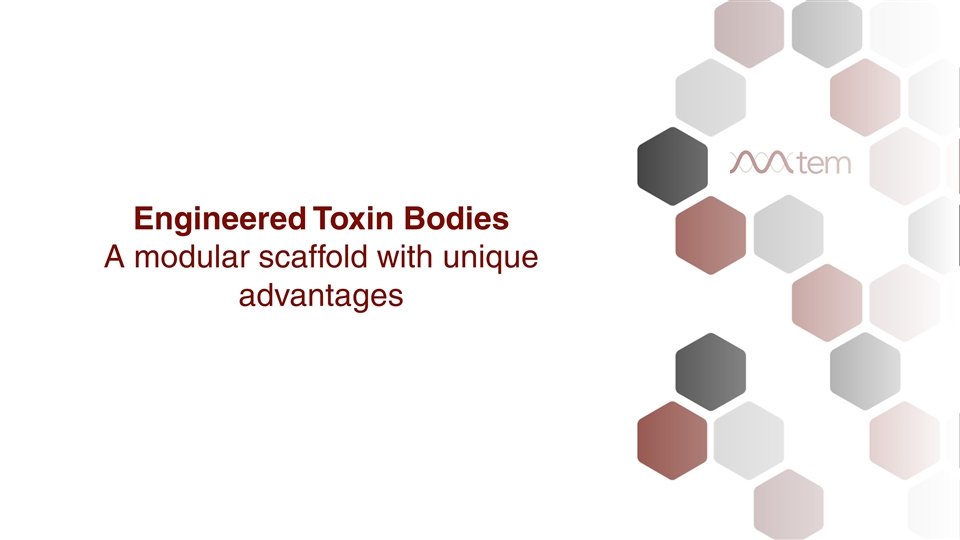
Engineered Toxin Bodies A modular scaffold with unique advantages
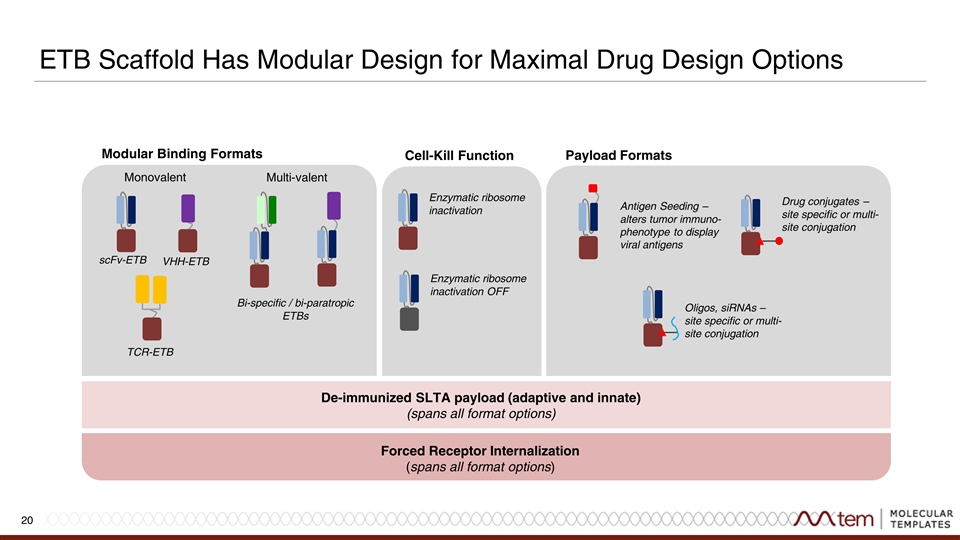
ETB Scaffold Has Modular Design for Maximal Drug Design Options Monovalent Multi-valent scFv-ETB VHH-ETB TCR-ETB Bi-specific / bi-paratropic ETBs Modular Binding Formats Payload Formats Drug conjugates – site specific or multi-site conjugation Oligos, siRNAs – site specific or multi-site conjugation Antigen Seeding – alters tumor immuno-phenotype to display viral antigens Enzymatic ribosome inactivation Enzymatic ribosome inactivation OFF Cell-Kill Function Forced Receptor Internalization (spans all format options) De-immunized SLTA payload (adaptive and innate) (spans all format options)
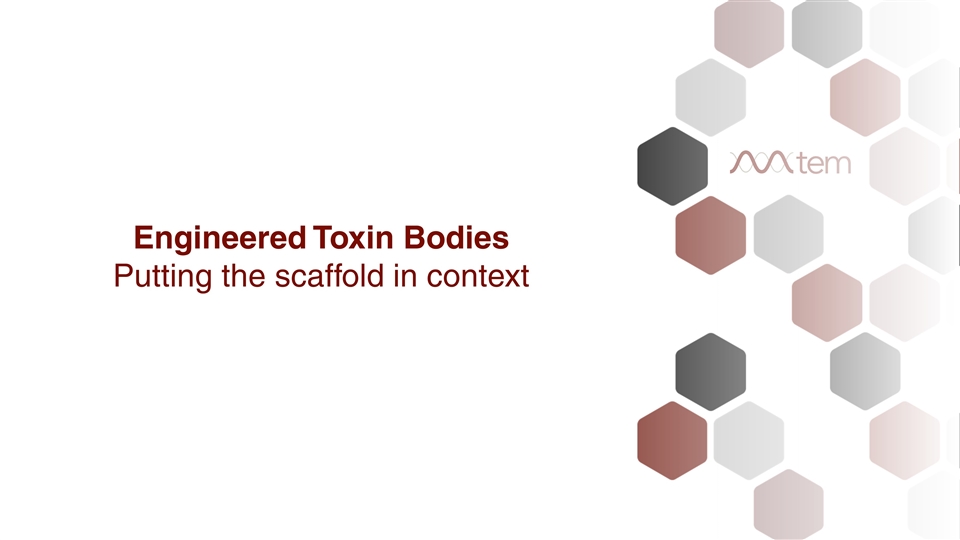
Engineered Toxin Bodies Putting the scaffold in context
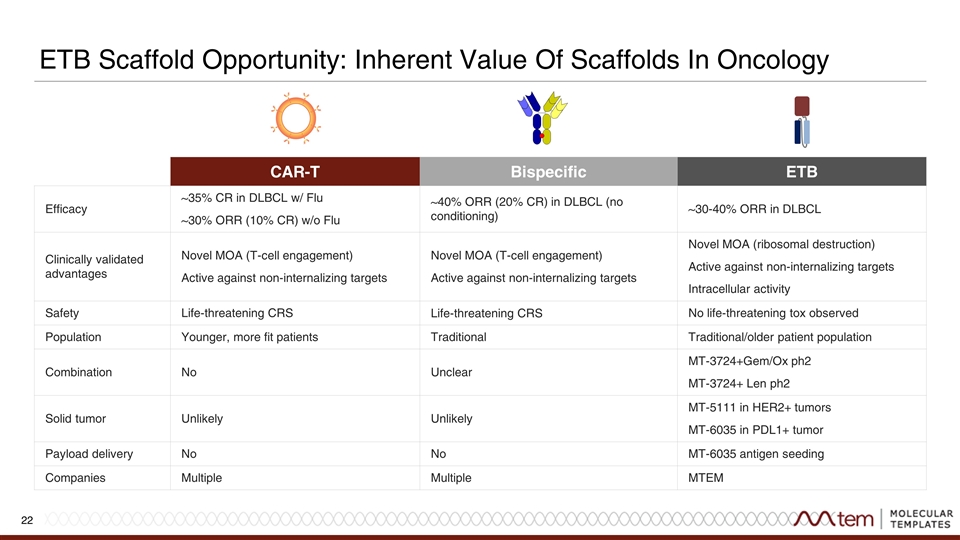
CAR-T Bispecific ETB Efficacy ~35% CR in DLBCL w/ Flu ~30% ORR (10% CR) w/o Flu ~40% ORR (20% CR) in DLBCL (no conditioning) ~30-40% ORR in DLBCL Clinically validated advantages Novel MOA (T-cell engagement) Active against non-internalizing targets Novel MOA (T-cell engagement) Active against non-internalizing targets Novel MOA (ribosomal destruction) Active against non-internalizing targets Intracellular activity Safety Life-threatening CRS Life-threatening CRS No life-threatening tox observed Population Younger, more fit patients Traditional Traditional/older patient population Combination No Unclear MT-3724+Gem/Ox ph2 MT-3724+ Len ph2 Solid tumor Unlikely Unlikely MT-5111 in HER2+ tumors MT-6035 in PDL1+ tumor Payload delivery No No MT-6035 antigen seeding Companies Multiple Multiple MTEM ETB Scaffold Opportunity: Inherent Value Of Scaffolds In Oncology
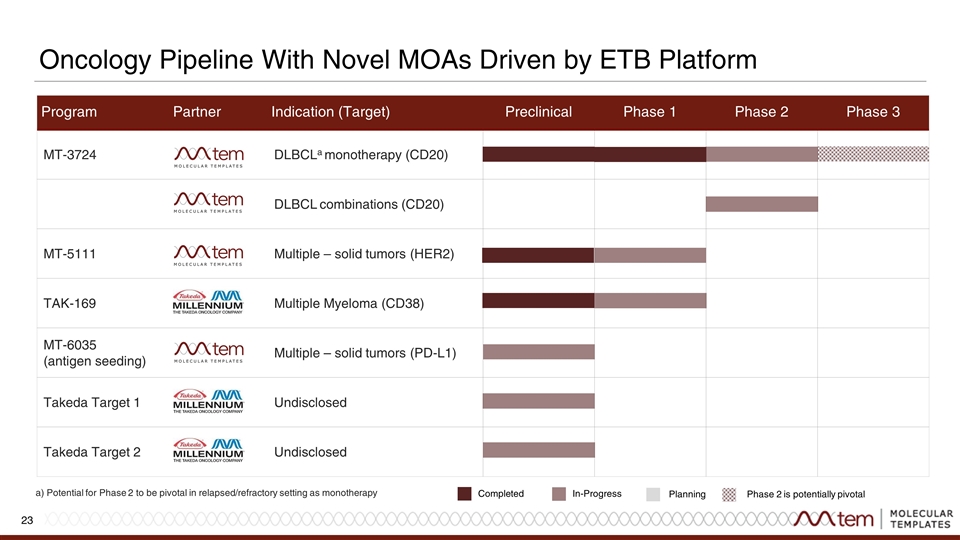
Program Partner Indication (Target) Preclinical Phase 1 Phase 2 Phase 3 MT-3724 DLBCLa monotherapy (CD20) DLBCL combinations (CD20) MT-5111 Multiple – solid tumors (HER2) TAK-169 Multiple Myeloma (CD38) MT-6035 (antigen seeding) Multiple – solid tumors (PD-L1) Takeda Target 1 Undisclosed Takeda Target 2 Undisclosed In-Progress Completed Planning a) Potential for Phase 2 to be pivotal in relapsed/refractory setting as monotherapy Oncology Pipeline With Novel MOAs Driven by ETB Platform Phase 2 is potentially pivotal
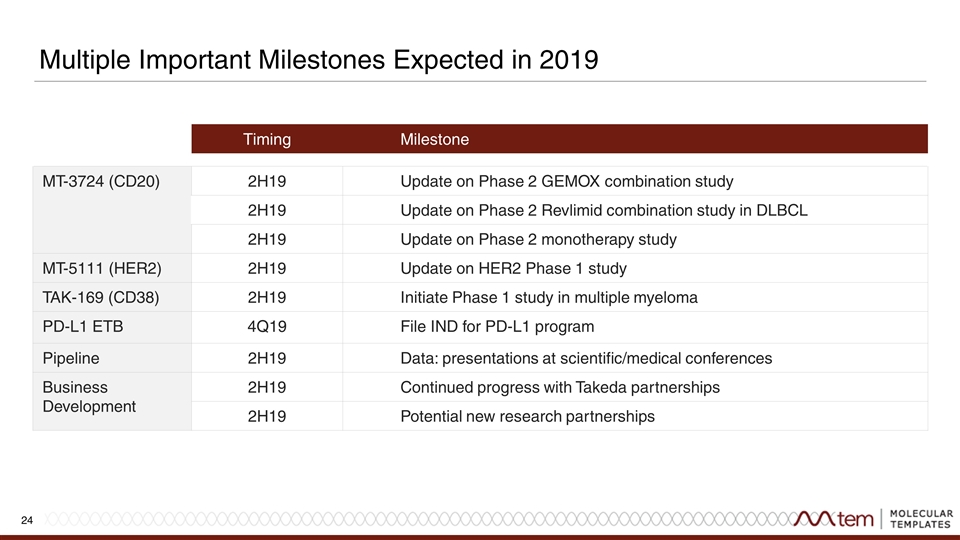
Timing Milestone MT-3724 (CD20) 2H19 Update on Phase 2 GEMOX combination study 2H19 Update on Phase 2 Revlimid combination study in DLBCL 2H19 Update on Phase 2 monotherapy study MT-5111 (HER2) 2H19 Update on HER2 Phase 1 study TAK-169 (CD38) 2H19 Initiate Phase 1 study in multiple myeloma PD-L1 ETB 4Q19 File IND for PD-L1 program Pipeline 2H19 Data: presentations at scientific/medical conferences Business Development 2H19 Continued progress with Takeda partnerships 2H19 Potential new research partnerships Multiple Important Milestones Expected in 2019
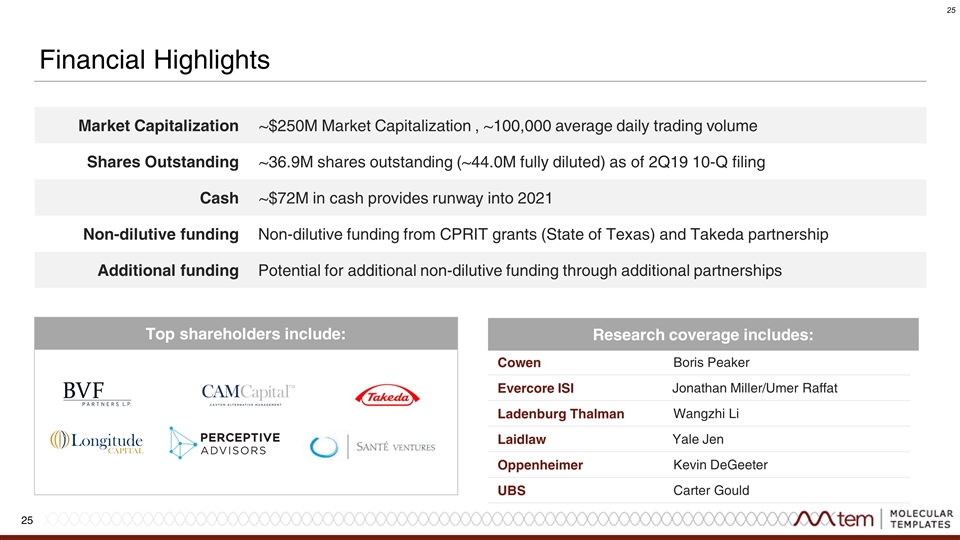
Top shareholders include: Market Capitalization ~$250M Market Capitalization , ~100,000 average daily trading volume Shares Outstanding ~36.9M shares outstanding (~44.0M fully diluted) as of 2Q19 10-Q filing Cash ~$72M in cash provides runway into 2021 Non-dilutive funding Non-dilutive funding from CPRIT grants (State of Texas) and Takeda partnership Additional funding Potential for additional non-dilutive funding through additional partnerships Financial Highlights Cowen Boris Peaker Evercore ISI Jonathan Miller/Umer Raffat Ladenburg Thalman Wangzhi Li Laidlaw Yale Jen Oppenheimer Kevin DeGeeter UBS Carter Gould Research coverage includes:
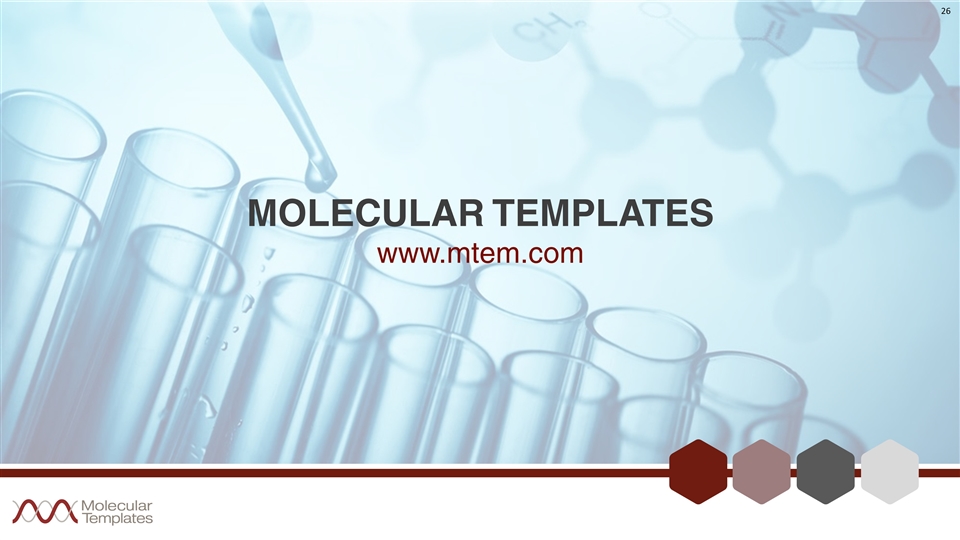
MOLECULAR TEMPLATES www.mtem.com (NASDAQ: MTEM)

























